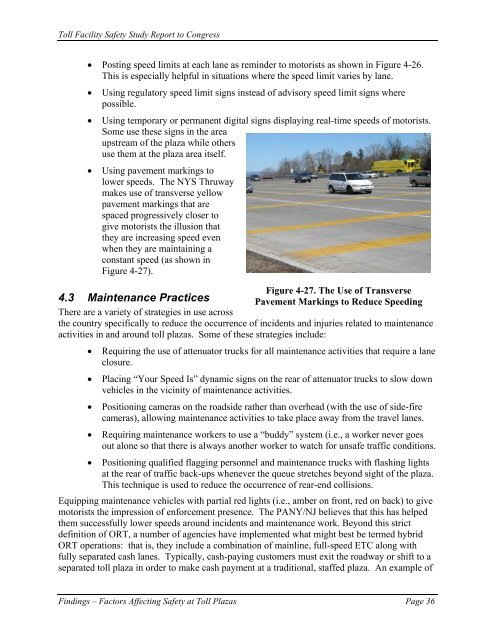Toll Facility Safety Study Report to Congress - About
Toll Facility Safety Study Report to Congress - About
Toll Facility Safety Study Report to Congress - About
You also want an ePaper? Increase the reach of your titles
YUMPU automatically turns print PDFs into web optimized ePapers that Google loves.
<strong>Toll</strong> <strong>Facility</strong> <strong>Safety</strong> <strong>Study</strong> <strong>Report</strong> <strong>to</strong> <strong>Congress</strong><br />
Posting speed limits at each lane as reminder <strong>to</strong> mo<strong>to</strong>rists as shown in Figure 4-26.<br />
This is especially helpful in situations where the speed limit varies by lane.<br />
Using regula<strong>to</strong>ry speed limit signs instead of advisory speed limit signs where<br />
possible.<br />
Using temporary or permanent digital signs displaying real-time speeds of mo<strong>to</strong>rists.<br />
Some use these signs in the area<br />
upstream of the plaza while others<br />
use them at the plaza area itself.<br />
Using pavement markings <strong>to</strong><br />
lower speeds. The NYS Thruway<br />
makes use of transverse yellow<br />
pavement markings that are<br />
spaced progressively closer <strong>to</strong><br />
give mo<strong>to</strong>rists the illusion that<br />
they are increasing speed even<br />
when they are maintaining a<br />
constant speed (as shown in<br />
Figure 4-27).<br />
4.3 Maintenance Practices<br />
There are a variety of strategies in use across<br />
Figure 4-27. The Use of Transverse<br />
Pavement Markings <strong>to</strong> Reduce Speeding<br />
the country specifically <strong>to</strong> reduce the occurrence of incidents and injuries related <strong>to</strong> maintenance<br />
activities in and around <strong>to</strong>ll plazas. Some of these strategies include:<br />
Requiring the use of attenua<strong>to</strong>r trucks for all maintenance activities that require a lane<br />
closure.<br />
Placing “Your Speed Is” dynamic signs on the rear of attenua<strong>to</strong>r trucks <strong>to</strong> slow down<br />
vehicles in the vicinity of maintenance activities.<br />
Positioning cameras on the roadside rather than overhead (with the use of side-fire<br />
cameras), allowing maintenance activities <strong>to</strong> take place away from the travel lanes.<br />
Requiring maintenance workers <strong>to</strong> use a “buddy” system (i.e., a worker never goes<br />
out alone so that there is always another worker <strong>to</strong> watch for unsafe traffic conditions.<br />
Positioning qualified flagging personnel and maintenance trucks with flashing lights<br />
at the rear of traffic back-ups whenever the queue stretches beyond sight of the plaza.<br />
This technique is used <strong>to</strong> reduce the occurrence of rear-end collisions.<br />
Equipping maintenance vehicles with partial red lights (i.e., amber on front, red on back) <strong>to</strong> give<br />
mo<strong>to</strong>rists the impression of enforcement presence. The PANY/NJ believes that this has helped<br />
them successfully lower speeds around incidents and maintenance work. Beyond this strict<br />
definition of ORT, a number of agencies have implemented what might best be termed hybrid<br />
ORT operations: that is, they include a combination of mainline, full-speed ETC along with<br />
fully separated cash lanes. Typically, cash-paying cus<strong>to</strong>mers must exit the roadway or shift <strong>to</strong> a<br />
separated <strong>to</strong>ll plaza in order <strong>to</strong> make cash payment at a traditional, staffed plaza. An example of<br />
Findings – Fac<strong>to</strong>rs Affecting <strong>Safety</strong> at <strong>Toll</strong> Plazas Page 36

















